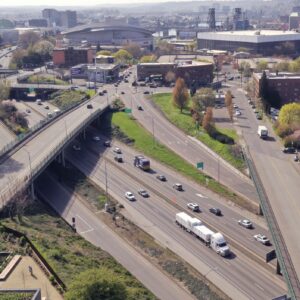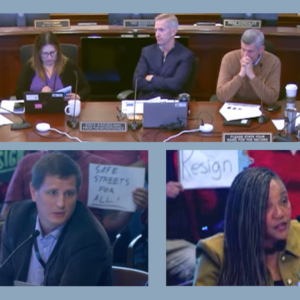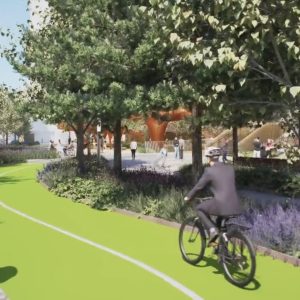[See this comment for an update.]
Yesterday I received a phone call from Shawn Karambelas, owner of SK Northwest (I had left a message for him last week). This is the company currently in escrow on a lot just south of OMSI on the Willamette River, smack dab in the middle of a potential trail connection between the Eastbank Esplanade and the Springwater Corridor Trail (for background on this story see this post).
He was clearly frustrated by the community push-back he has received so far and I could sense the anxiety in his voice. I had to re-assure him several times that I wasn’t out to get him and that I just wanted to find out more about his intentions.
What I heard from Karambelas is that he came into this deal initially willling work with the City of Portland on the trail easement issue. However, the person he’s buying the property from, Wayne Kingsley (more on Kingsley), has added a clause in the purchase contract that says Karambelas must fight against the trail if he wants to buy the property. According to Karamebelas:
“Kingsley has made it crystal clear to me that he doesn’t want a trail across this property. Initially I wanted to work out a deal with the city, but he (Kingsley) put a new clause in the contract that said if I continued to want the propery I must agree to fight the trail. Basically my hands are tied, I’m screwed.”
But Karambelas isn’t exactly all for the trail either. Like Kingsley, he has major concerns about safety, especially not wanting the liability exposure in case of an accident. He described the potential scene:
“The trail would go through a busy area full of fork lifts, packing crate material, trailers, and ATV’s and I don’t want that kind of exposure.”
He suggested that in order to avoid all this, some sort of bridge would have be built. But after estimating the potential costs in his head he added, “Unfortunately, it’s cheaper to fight the trail than to build it.”
I asked Karambelas if he thought there was any way to find a solution that includes the trail. He didn’t really have much optimism for this and even seemed incredulous that the community was still fighting for the trail. Because, in his words:
“It’s like I’m an island (between Portland Spirit and Ross Island Cement) and there’s no way a trail can be built on either side in the foreseeable future anyways.”
I told him that many people in the community were concerned that his proposed dock – which he claims would be for repairs only – would be a trojan horse that would lead to a free-for-all of motorized recreational use of the river. Clearly frustrated by having to defend this point again, he said the dock will only be used by technicians to test and diagnose watercraft. He also added that, “besides, the area is currently zoned industrial so that limits the potential for recreational use.”
Karambelas told me that he was a former member of the rowing team at Oregon State University from 89-’93 and that he can relate to people’s concerns about motorized vehicles running amok in the Willamette. He said, “I was a rower myself and I have no intention of ruining that experience for anyone else.”
If that’s true, I asked why doesn’t he just use indoor water tanks for testing and repairs, to which he replied:
“Despite some of the comments I’ve read on your site, test tanks are not adequate for what we need. We must use open water to properly test the engines.”
At this point, this case will go before the City of Portland Bureau of Development Services for a decision. According to Karambelas, his lawyers think he has a very strong case and he thinks it’s very likely he will win and move forward with his plans. He said Kingsley has already successfully fought and won a case very similar to this.
From my perspective, this situation is in critical condition. Since my conversation with Wayne Kingsley, I’ve learned he’s a powerful figure who has stymied and vehemently opposed many transportation projects in the past. My fear is that if he wins this battle, we will not only lose the potential of an important connection of the Springwater Trail, but we might lose the peaceful and relaxing experience of riding along a calm and quiet Willamette River.
If you’ve ever been near a personal watercraft as it whips through the water, spewing exhaust in the air and river, sounding like a Harley on water, you’ll know why I’m concerned.
[Although the comment period is officially over (as of 4/27), the case is still pending and I urge everyone to contact Kate Green at the Bureau of Development Services and CC the message to City Council. Use this handy link to email all them at once.]






Thanks for reading.
BikePortland has served this community with independent community journalism since 2005. We rely on subscriptions from readers like you to survive. Your financial support is vital in keeping this valuable resource alive and well.
Please subscribe today to strengthen and expand our work.
So what can a concerned citiaen such as myself do? Are there any more city officials to whom I can send waves of emails?
While official comment period is over, I’d urge folks to continue to advocate for the trail with all of City Council — especially Leonard, Potter, and Adams. If the City holds firm for the trail, it’s a rock against a hard place, and the costs of a lawsuit might soon outstrip the costs of finding another solution.
UPDATE: I just spoke with Andy Peterson (Kate Green’s boss) at BDS. He said SK Northwest has put the application on hold. SK realized BDS might rule against their application and they want time to gather more information before moving forward.
If BDS denies the application process, SK Northwest can (and I’m sure will) appeal.
If BDS approves it, there will be an opportunity for a public appeal process, which is usually handled by the neighborhood association. In this case that would be Hosford-Abernethy.
Perhapses, with the sunny days people should be on the spring water trail handing out fliers and educating people who use the trail what is going to happen. Also a media push may be in order as well. I am down to spend a few hours on the spring water talking to people that use it what will soon happen if they do not speak out.
“Save the Springwater” has a ring to it.
What concerns me is that I haven’t heard/seen the same story twice from SK and it’s attorney. One day they say the dock is only for mechanical test runs, the next they say it’s may ultimately be for leased moorage to capture overflow from Riverplace. They cite “industrial” zoning as limiting them to repair work and no “recreational” or retail, yet on a different day they say they may evolve into retail. The problem is, once the City permits the facility, they don’t have that much control over what actually happens.
In Seattle years ago, the industrial users of the area in Fremont-Ballard where the Burke Gilman was supposed to go got all upset. The trail was built, with some fencing and some designated industrial crossovers, and it works pretty darned well. There’s no reason that the easement requirement should be waived…after all, there’s no guarantee that RISG or Portland Spirit will be there forever.
I have been doing some more research on the whole test tank issue. It turns out Shawn does have a reason for wanting open water for engine/pump tests.
If you have a sense of humor . . . It’s actually kind of funny (in a twisted way). One of the main problems is that the watercraft tested in a tank end up heavily polluting the water . . . so much so in one case that someone had to be hired full-time to clean the gunk off the hulls when they came out. To quote “The test tank was laden with carbon, oils, dirt, and hydrocarbons”. Apparently the size of these particles is also very small (98% below 5 microns), making filtration difficult . . . I suppose it is much easier to put all that crap in the river than have to deal with it in a closed system.
For the record though, I found at least one company that designs filters for just this kind of application.
As for the dock . . . SK’s own plans show a layout/size with a much greater capacity than repair testing would warrant. Couple that with the mixed messages outlined above and you ave a pretty fishy situation.
On the flip side . . . it can’t be fun being Kingsley’s moll . . . he probably had no idea what he was getting into.
I think if they push it through somehow a large 5mph (no wake) zone in the adjacent stretch of river and a ban on Segways on the trail system would be a good way to reward the bad behavior. I bet testing a watercraft at idle doesn’t work too well either, and I for one would love to see the Segways trying their luck out on the streets nearby, using their amazing manueverability to dodge the heavy trucks in the area.
So if everything fails, and SK Northwest keeps their property; I just keep riding the same route I always have? I can deal with that, I’ve never run across any problems on that route, can’t always win.
I guess I shouldn’t expect more from anyone involved with such an awful contraption as a jet-ski, but the thing that strikes me most is that SK just doesn’t get the importance of the Springwater trail and what it means to Portland.
It’s not so much a question of legally can they stop the trail from crossing the property. I really wonder why this business would want to take a crap, essentially, on something that represents an important Portland ideal. They don’t get it. It’s like they just moved here from LA or something.
He’s concerned about the safety of cyclists going through there because it would be “a busy area full of fork lifts, packing crate material, trailers, and ATV’s”??? Puh-lease!! If I understand correctly what area this is, an area I travel through probably 10 times a week, cyclists already handle debris from Ross Island (sand, gravel, grit in the air), construction, large trucks, passenger vehicles, and fork lifts and as far as I know we’ve been doing pretty well.
Has anyone said what will happen if this goes through? Will the bike path just end right at the stop sign at the end of the Springwater Corrider or will there be access to some other road to loop around to the Esplande? This is really a concern because there is no other way off the trail once you get on at Oaks Park.
I’m grateful that Mr. Karambelas’ is participating in the dialogue, but I’m not convinced by his explanation.
1. The proposed site drawing shows 36 boat slips. They can’t possibly need that many spaces for “testing.” The current design and public statements both show the intended use.
2. Why would anyone ever sign a purchase agreement that REQUIRES the buyer to engage in an expensive, bloody land use fight both with the City of Portland and the region’s well-organized bike and trail advocates? A clause like that is probably not enforceable, legally. In any case, SK’s name is initiating the action, so they need to take responsibility for their proposal–not put blame on on Kingsley or a contract provision.
3. If the concern is cyclist safety, there are numerous examples of well-designed crossings of recreational trails, including the Seattle example cited above. This is a solvable design problem, not reason to oppose the trail. Likewise, I’m sure the city has some kind of liability agreement for trail easements that would limit SK’s exposure, as long as the crossing was designed well.
4. It will definitely be cheaper to work out a solution than to fight the City and the assembled forces of the region’s bike, pedestrian, and trail advocates. We can drag this out, and those bills from Ball Janik add up pretty quick. Cha-ching! Not to mention the P.R. damage to SK’s business.
pdxrocket said:
“So if everything fails, and SK Northwest keeps their property; I just keep riding the same route I always have? I can deal with that, I’ve never run across any problems on that route, can’t always win.”
The Springwater/Esplanade are the centerpieces of our bike network. We are attempting to make Portland a major leader in bicycling innovations, including infrastructure, as an economic, ecological, and civic investment. The current four block detour is not a big deal for those of who ride often. But think of the future. Think of those visitors coming to Portland to learn how to build a bicycling network, only to navigate in between an 18-wheeler and a cement truck. That is not an example of a highly functioning shared-use path.
No, we need to fight for a continuous Springwater for two reasons: 1. In the long run, a continuous trail will mean more to the city than a business. 2. It is another symbolic fight for bicycling legitimacy. Really.
Did the BTA really need to sue the City of Portland in 1995 to force the striping of bike lanes on a 1/4 mile stretch around the Rose Garden? The old way, riding with traffic, served bicyclists fine. But the BTA knew that if the city hedged on those bike lanes, it could continue to flaunt the law (which required a certain amount to be spent on bicycle and pedestrian projects when other transportation funds were being spent) the next time a bike lane was inconvenient.
This Springwater question is similar. Should we continue to give away our right to invaluable public space that will serve thousands of Portlanders, both directly and indirectly? And how many people will benefit if SK gets the permit?
This is one worth fighting for.
To get an idea of what a break in the trail will create, just look at this picture
http://www.flickr.com/photos/60961560@N00/138059156/
Wrong one, disregard the last one (though it’s nice)
http://www.flickr.com/photos/60961560@N00/128150349/
Well said, Scott (comment #11)!
The whole issue is bigger than just a few hundred feet of easement…it’s about setting the stage for the future of Portland.
Maybe the problem is the “Spirit of Portland” does not have or get the true spirit of Portland…remember Waterfront Park was once a freeway. They seem to be looking for a fight.
Defend the Springwater Trail!
I sent email to Kate Green et. al. thanks to the contact info posted here, and today’s mail included a copy of the Land Use Division’s report (apparently sent to all respondants):
SK’s proposal was DENIED! There were multiple areas in which the proposal did not meet Land Use requirements or criteria. They have until June 23 to file an appeal.
It is easy to decide that Karambelas should donate a bike path on his land, maintain it, and be liable for injuries occuring on it. But try understanding his position for a minute. What if the City decided they wanted to put a bike path through YOUR front yard, with the same obligations and liabilities. “But that’s different!”. No it isn’t. As the old saying goes, you spend your own money a lot different than you spend someone elses.
I don’t know that anyone’s suggesting SK would maintain the path or be liable for injuries that aren’t caused by SK.
The analogy is if I were buying an undeveloped property, I’d have to negotiate a lot of items with the seller, and one might be that the property happens to have a trail planned across it. If I want to buy the property, I provide the right-of-way for the trail, if I don’t want that right-of-way, I find another property.
Actually, Portland did decide it wanted a bike path through my front yard. They call it a street. Here’s what happened:
The developer of my neighborhood purchased a big tract of undeveloped land–in 1916. The accepted rule at the time was no different than it is now. If he wanted permission to develop the property, he had to build streets and sidewalks for common use and then hand that land over to the city. This includes a swath of land that would have otherwise been “my” front yard.
Sometimes I fume at the injustice of this uncompensated taking of private land. Mostly though, I just enjoy biking and driving on the streets of my neighborhood.
Evan- the city code that covers the issue of recreational trail construction was passed quite recently. It was not in place when the man who is selling it bought the land. And please read it, it does require that the person building on land with recreational stars across it must not only build the path, but maintain and insure it. There is a rememdy, if you can’t afford to insure it you can donate the land (that you probably worked very hard to earn the money to buy) to the city.
Benshcoh- You make my point. The street wasn’t taken from you- you didn’t own the property. Yes, developers were required to donate land for a street, but that was also in their interest- how do you sell a house without a street? But a bikepath through Karambela’s propety is NOT in his interest- although I can see how it is in yours.
You enjoy riding on bike paths, but I am sure you would ‘fume at injustice’ if the City decided they wanted you to put one in your yard.
Please at least try to understand why Mr Karambela is not anxious to supply you with a lovely trail to ride on at his expense.
Many people think a multi-use path would be in owners’ interest, so that the trucks and bikes and walkers don’t have to intersect in dangerous ways (truck deliveries wouldn’t be slowed down as much, etc.). Also, customers may choose to go to SK by bike.
Certainly I understand SK’s position. But I think it’s fair to disagree with it and think that it’s in the best interests of the City to have a trail.
And thanks for the correction — that only if the trail continues to be owned by the private owner is maintenance and liability an issue. My bad.
The city would maintain the trail and assume liability for it, if that’s what SK wants. Look at the recreational trails chapter of the code again, specifically 33.272.070(A).
But seriously, if it were really about maintenance and liability, the city and SK would be able to work out some kind of a deal. Right? Likewise, if it were really about potential trail crossing conflicts, there are dozens of tested, successful design solutions out there.
The basic problem is that Kingsley and Karambelas don’t want the trail to be there, period.
I respect your opinion, Susan, and Mr. Karambelas’ too. I just think he’s making an incredibly narrow, selfish assessment of his interest.